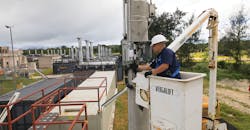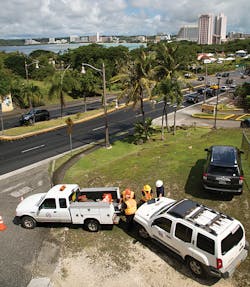Established in 1968 with headquarters in the Village of Mangilao on the eastern shore of Guam, Guam Power Authority (GPA) provides electrical service to 50,000 residences, businesses, the local government and federal agencies of this U.S. territory. Like most island utilities, GPA has no conventional energy resources and relies primarily on petroleum products shipped in by tanker to meet most energy needs. Operating as both a generation and distribution utility, GPA maintains 663 miles (1067 km) of transmission and distribution lines and 29 substations.
Through a grant from the U.S. Department of Energy, as part of the American Recovery and Reinvestment Act, GPA was awarded US$16.7 million to help fund 50% of a grid modernization project. The project involved a territorywide deployment of advanced metering infrastructure (AMI) and integration of the AMI with an outage management system (OMS). GPA also implemented substation automation equipment, including voltage regulators, fault indicators, smart relays and transformer monitors. An energy management system was deployed to leverage the new automation assets.
With AMI, GPA aimed to enable many new efficient and cost-saving services, such as remote service connect and disconnect, outage notification, restoration verification, tamper and theft notification, and home area network connectivity. Additionally, with the OMS, the utility wanted the ability to pinpoint outages and quickly focus the efforts of its field personnel.
Core Technologies
GPA uses Landis & Gyr’s Gridstream solution for Tier 1 communications with meters. To support AMI Tier 2 communications, GPA chose point-to-multipoint (PTMP) mesh radio technology from ABB because it offers self-healing capabilities should a node fail. Self-healing capability is an important consideration in an area such as Guam that has a high risk of Category 4 and Category 5 typhoons, which can bring potentially sweeping winds of up to 200 mph (322 kmph).
The field area Tier 2 network spans about 80% of the island of Guam, providing bidirectional communications between AMI collectors and the utility head-end systems. For backhaul of the field area network (FAN), GPA uses a Tier 1 fiber network, where available (approximately 56% of the utility’s substations have fiber); in other locations, contracted communications services are used.
Another consideration unique to island power generation is GPA’s wind turbine project. The utility leverages the network for bidirectional communication to a wind turbine generator, enabling remote monitoring and control of the device.
Territorywide Rollout
With the network foundation in place, a territorywide rollout of more than 50,000 Landis & Gyr smart meters took place from October 2012 to June 2014. It took crews several minutes to install the meters, which, once powered, immediately connected to the communications grid network. The smart meters connect to Landis & Gyr’s Gridstream RF Mesh, a narrowband metering local area network that provides bidirectional communication between smart meters and uses the TropOS FAN for backhaul to connect to the utility’s head-end systems. Approximately 88% of the meters are residential, with commercial, government and industrial customers filling in the remainder of the total.
GPA selected Harris Utilities’ SmartWorks MeterSense, a meter data management (MDM) solution that analyzes, interprets and manages the growing volumes of meter data. It links staff and operations to other applications, including the AMI system. The Milsoft OMS works synergistically with the AMI system to provide operational intelligence that enables more efficient and accurate outage detection and restoration verification.
GPA installed smart relays and transformer health sensors to monitor these devices centrally, identifying potential problems in seven of 29 substations. The utility intends to convert its supervisory control and data acquisition (SCADA) data circuits from private carriers to its own TropOS wireless and internal islandwide fiber network, which would include its sister utility, the Guam Waterworks Authority (GWA).
Benefits and Results
While the infrastructure upgrades have boosted customer satisfaction indirectly, the SmartWorks CustomerConnect web portal has had more of a direct impact on satisfaction. GPA’s residential and business customers can view their own power usage now, enabling them to manage consumption and energy costs better.
GPA has experienced significant benefits from its smart grid work, including a 13% increase in customer satisfaction. With the ability to read meters reliably from a remote location, GPA has reduced its electric meter reading costs by $433,417 per year. Additional cost savings of $120,990 per year were realized through reduced metering operating and maintenance costs. Truck rolls have dropped from 400 per month to 800 per month to now 3 per month, saving on vehicle fuel costs and reducing greenhouse gas emissions.
Additionally, the time to turn power service on and off has dropped drastically, from an average of 48 hours (because of scheduling and truck rolls) to 2 minutes. As a result, GPA lowered its reconnection fee for customers from $35 to $10. The time for closing out billing when a customer cancels service has dropped from 2 weeks to 3 weeks to just a few minutes now, which also has increased payment collections.
Additionally, the AMI system, Landis & Gyr advanced analytics and command center as well as the OMS are enabling GPA to be more responsive to power-quality issues, improving service reliability and accelerated outage restoration. Now, when crews go out to the field, they know quickly where the physical location of an outage is and which customers are affected. Also, operations personnel can ping meters remotely during an outage to confirm service restoration rather than having to call customers.
Lessons Learned
GPA’s ability to assemble a dedicated implementation team comprising of a program management office and experienced personnel to work alongside and guide the core project team was a critical success factor, given the scale of the deployment and size of the utility. This team drove alignment, commitment and partnerships across multiple divisions to overcome some internal challenges. GPA groups that had a role in the decision making included operations, customer service, communications, engineering, information technology, program management office and the general manager for consolidated utility services. GPA leadership fully supported the implementation and empowered the team to keep the project on track.
In addition, GPA identified an opportunity for sister utility GWA — also managed by the Consolidated Commission on Utilities — to leverage the same communications network for its SCADA as well as other telemetry and control applications, modernizing water utility efforts. GPA and GWA have a joint, ongoing SCADA project. GPA does not currently have SCADA in place. However, GWA has nine remote terminal units on the Tier 2 network currently reporting GWA critical asset alarms. When the SCADA project is complete, about 340 GWA facilities will be served by the Tier 2 and Tier 1 network.
Moreover, GPA is leveraging the network to connect a host of SCADA devices, which previously had been connected using leased telephone lines. By converting all SCADA data circuits from a private carrier to a private wireless network and internal islandwide fiber, GPA will save more than $300,000 annually. In addition, GWA and GPA will eliminate more than $500,000 of spend annually on communications for new applications, such as SCADA, other telemetry and control applications, and mobile workforce management.
A key design decision in GPA’s smart grid strategy was to build foundational infrastructure such as the Tier 1, 2 and 3 networks to serve future applications and technology needs. Communications infrastructure is foundational to creating flexibility and capability for the future while serving the present needs.
GPA has experienced the benefits of a smart grid deployment at every step and will continue to enhance and expand its capabilities, especially as it pertains to substation automation, demand-side management and mobile workforce management. At the end of the smart grid implementation, GPA realized a double-digit increase of 11% in residential customer satisfaction. In the end, it is all about serving customers better. ♦
John J. Cruz is the assistant general manager of engineering and technical service at Guam Power Authority. He oversees operations for planning and regulatory, engineering, information technology and the strategic planning and operations division (SPORD). Cruz has 25 years of experience with GPA, having previously served as the manager for SPORD. He is a professional engineer.
Roel A. Cahinhinan is a special projects engineer in the strategic planning and operations division (SPORD) at Guam Power Authority. Cahinhinan led GPA’s 2010 long-range transmission plan and most recent load study. He is the lead for GPA’s smart grid program. He is a professional engineer.
Check out the February 2018 issue for more articles, news and commentary.
About the Author
John J. Cruz
John J. Cruz is the assistant general manager of engineering and technical service at Guam Power Authority. He oversees operations for planning and regulatory, engineering, information technology and the strategic planning and operations division (SPORD). Cruz has 25 years of experience with Guam Power Authority, having previously served as the manager for SPORD. He is a professional engineer.


